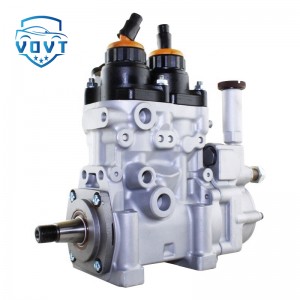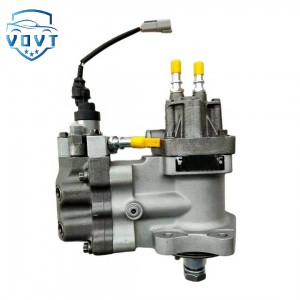Diesel Fuel Injection Pump 4P-5727 4P-5728 4W-6017 7C-4567 112-4057 115-3576 141-1238 141-7869 For CAT 3116 Engine Auto Engine Part
products description
| Reference Code | 3116 |
| MOQ | 1 PCS |
| Certification | ISO9001 |
| Place of Origin | China |
| Packaging | Neutral packing |
| Quality Control | 100% tested before shipment |
| Lead time | 7~15 working days |
| Payment | T/T, Western Union, Money Gram, Paypal, Alipay, Wechat |
Introduction of diesel fuel pump
Main types of diesel oil pumps
1. Mechanical plunger fuel pump (traditional pump)
Application scenarios:
Mainly used for old diesel engines or small diesel engines (such as agricultural vehicles and engineering machinery), driven by the engine camshaft, with a simple structure but low control accuracy.
Core structure:
Plunger assembly:
Plunger: reciprocates in the plunger sleeve, and controls the oil supply by changing the plunger stroke.
Plunger sleeve: The inner wall is precisely machined to form a high-pressure sealed space with the plunger.
Oil outlet valve:
Located above the plunger, it includes a valve seat and a valve core. Its function is to quickly cut off the oil circuit at the end of oil supply, prevent fuel reflux, and maintain residual pressure in the high-pressure oil pipe.
Camshaft and roller body:
The camshaft is driven by the engine crankshaft, and the plunger is pushed upward (oil supply) through the roller body, and the plunger is driven downward (oil absorption) under the action of the spring.
Oil quantity adjustment mechanism:
Fork or rack-gear ring mechanism: By changing the relative position of the plunger bevel and the oil inlet hole, the effective stroke of the plunger is adjusted to control the oil supply.
2. High-pressure common rail fuel pump (modern electronically controlled pump)
Application scenario:
Widely used in electronically controlled diesel engines (such as Bosch and Denso systems) of passenger cars and commercial vehicles, and cooperates with ECU (electronic control unit) to achieve high-precision fuel injection.
Core structure:
Low-pressure fuel pump:
Gear pump or vane pump, responsible for sucking oil from the fuel tank and pressurizing it to 0.3-0.6MPa, and delivering it to the high-pressure fuel pump.
High-pressure pump body:
Plunger assembly:
Usually 3 plungers (at an angle of 120°), driven by the drive shaft to rotate the eccentric cam, and the plunger reciprocates under the action of the cam and spring to pressurize the low-pressure fuel to more than 100-200MPa.
Pressure regulating valve (PCV):
Controlled by ECU, it accurately controls the fuel pressure in the common rail pipe by adjusting the amount of refluxed fuel.
Oil outlet valve and one-way valve:
Prevent high-pressure fuel from reflux and ensure stable pressure in the common rail pipe.
Drive shaft and coupling:
Driven by the engine crankshaft through gears or chains, the speed is usually half of the crankshaft speed (four-stroke engine).
3. Unit Pump
Application scenario:
Mostly used in heavy-duty diesel engines (such as trucks and ships), each cylinder is equipped with an independent oil pump, which is directly installed on the cylinder head.
Core features:
Compact structure, directly drive the plunger through the camshaft, and can generate extremely high pressure (more than 200MPa).
No common rail pipe is required, and the high-pressure fuel output by the plunger pump is directly delivered to the injector through the high-pressure oil pipe.
Working principle of high-pressure common rail fuel pump
1. Low-pressure fuel delivery stage
After the fuel in the fuel tank is filtered by the coarse filter, it is pressurized to 0.3-0.6MPa by the low-pressure fuel pump and enters the high-pressure pump through the fuel filter (fine filter, filtration accuracy 5-10μm).
2. High-pressure fuel generation stage
Oil absorption process:
The plunger moves downward under the action of the spring, the plunger cavity volume increases, the inlet valve opens, and low-pressure fuel enters the plunger cavity.
Oil compression process:
The drive shaft drives the cam to rotate, pushing the plunger upward, the inlet valve closes, the fuel in the plunger cavity is compressed, the pressure rises suddenly (up to 200MPa), the outlet valve is pushed open, and the high-pressure fuel enters the common rail pipe through the outlet.
Pressure regulation:
The ECU controls the pressure regulating valve (PCV) according to the engine operating condition signal (such as speed, load). If the common rail pressure is too high, the PCV valve opens, and part of the fuel flows back to the low-pressure oil circuit. Otherwise, it closes to maintain pressure.
3. Fuel injection stage
The high-pressure fuel in the common rail pipe is transported to the injectors of each cylinder through the high-pressure oil pipe. The ECU accurately controls the injection amount and injection time by controlling the opening time (pulse width) and number of the injector solenoid valve.
Technical requirements for key components
Plunger and plunger sleeve:
Material: High-strength alloy steel (such as nitrided steel), surface hardness of HV1000 or above, matching clearance of only 3-5μm, requires precision grinding and matching (not interchangeable).
Function: Form a high-pressure sealed space to withstand high-frequency reciprocating motion and fuel flushing.
Pressure regulating valve (PCV):
Response speed: Opening and closing must be completed within milliseconds to adjust the common rail pressure in real time.
Sealing: No leakage under 200MPa high pressure, usually using ball valve or cone valve structure.
Drive shaft and bearing:
Wear resistance: The drive shaft speed can reach 3000-4000rpm, the bearing needs to withstand radial and axial loads, needle bearings or sliding bearings are used, and lubrication depends on engine oil.
Common faults and causes
Fault phenomenon Possible cause
Lack of engine power 1. Wear of low-pressure fuel pump, insufficient fuel supply;
2. Wear of plunger or oil outlet valve, failure to establish high pressure;
3. PCV valve stuck or circuit failure.
Fuel leakage 1. Aging of plunger sleeve seal ring;
2. Loosening of high-pressure oil pipe joint;
3. Cracks in pump body (mostly due to external impact or corrosion).
Abnormal noise 1. Air intake in low-pressure oil circuit (abnormal sound when oil pump sucks air);
2. Wear of drive shaft bearing;
3. Excessive clearance between plunger and cam.
Excessive emission 1. Unstable common rail pressure, resulting in poor atomization of fuel injection;
2. The oil quantity adjustment mechanism is stuck and the fuel supply is abnormal.
Maintenance points
Fuel cleanliness:
Replace the fuel filter regularly (it is recommended to replace it every 20,000 kilometers or shorten the cycle according to the operating conditions) to prevent impurities from entering the oil pump and wearing the plunger pair.
Use diesel that meets the standards (sulfur content <10ppm) to prevent sulfide corrosion of components.
Oil circuit sealing:
Check whether there are leaks in the low-pressure oil circuit (from the tank to the oil pump) (such as aging of joints and pipes), which can be tested by pressure testing with a hand oil pump.
High-pressure pump calibration:
The electronically controlled pump needs to match the ECU parameters through a special diagnostic instrument (such as the Bosch EDC17 system) to ensure the accuracy of pressure regulation.
Avoid dry running:
After replacing the fuel filter, the air in the oil circuit must be exhausted to prevent the oil pump from idling and burning the plunger and bearings.























